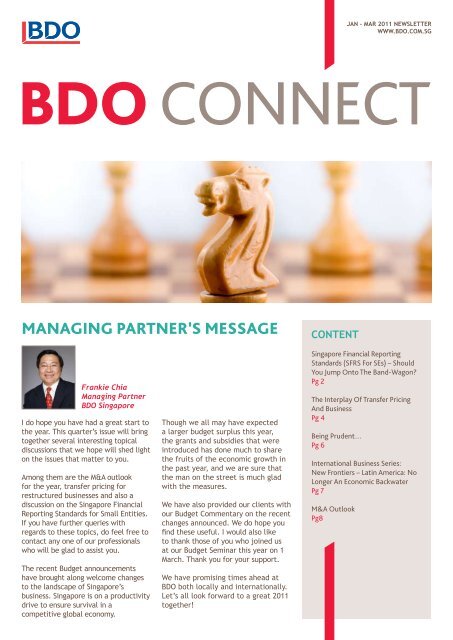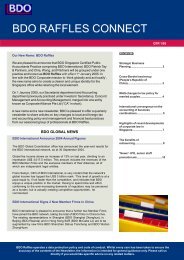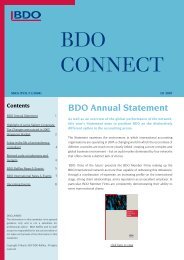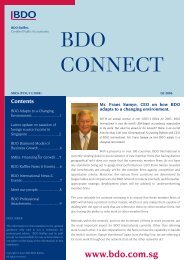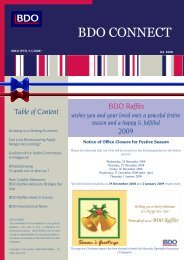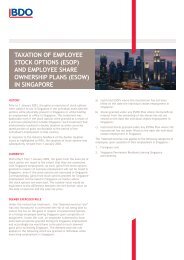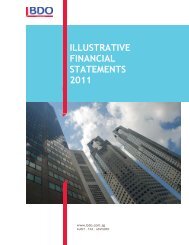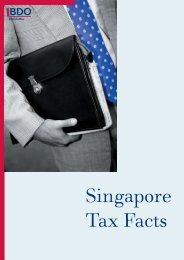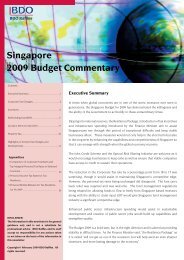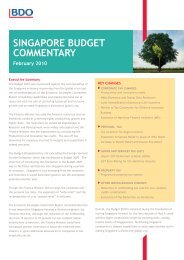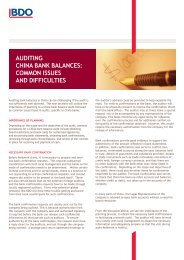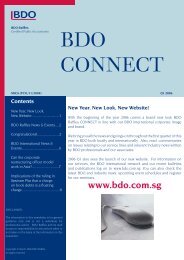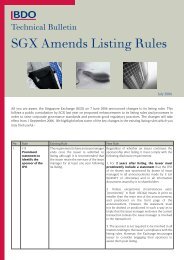MANAGING PARTNER'S MESSAGE - bdo singapore
MANAGING PARTNER'S MESSAGE - bdo singapore
MANAGING PARTNER'S MESSAGE - bdo singapore
- No tags were found...
You also want an ePaper? Increase the reach of your titles
YUMPU automatically turns print PDFs into web optimized ePapers that Google loves.
BDO CONNECT 2SINGAPORE NEWSChinnu Palanivelu, AssistantAudit Manager, on the Board ofAssociation of Certified FraudExaminer (USA), Singapore ChapterChinnu Palanivelu,Assistant AuditManager at BDOLLP has recentlybeen elected aboard member ofthe Association ofCertified Fraud Examiners (USA),Singapore Chapter. Chinnu hadbeen awarded the Lifelong Learneraward organised by MediaCorpRadio and the Singapore WorkforceDevelopment Agency. Chinnu hasuniversity degrees, diplomas and atleast 30 other training certificatesand qualifications, and is truly alifelong learner.BDO Budget Update 2011, 1 March 2011Over 60 participants joined ourBudget Update 2011 seminar tounderstand the key budget changesin 2011 and its impact on thecurrent economy, corporationsand businesses. Attendees learntmore about the key implicationsof this year’s Budget. The sessionwas led by our Head of Tax, MrRohan Solapurkar. We were joinedby Dr Tan Kee Wee, an independenteconomist who commented on theeconomics relevant to Budget 2011.Other speakers included, AssociateDirector, Michelle Seat and SeniorTax Consultant, Manmohan Singh.SINGAPORE FINANCIAL REPORTINGSTANDARDS (SFRS FOR SES)SHOULD YOU JUMP ONTO THEBAND-WAGON?By Narissa Chen,Audit Technical & Training ManagerT: 6828 9178E: narissachen@<strong>bdo</strong>.com.sgThe introduction of Singapore FinancialReporting Standards for Small Entities(SFRS for SEs or the Standard) in December2010, which is effective for annual periodsbeginning on or after 1 January 2011,gives qualifying entities an alternative tothe existing Singapore Financial ReportingStandards (SFRS) to adopt a purportedlymore user-friendly and cost efficientfinancial reporting framework.STANDALONE STANDARDSFRS for SE is a completely stand-alonestandard with only one “fallback” optionto SFRS with regards to the application ofSFRS 39 for recognition and measurement(and not disclosure) provisions.SIMPLER ALTERNATIVEAt fewer than 240 pages, SFRS for SEboasts a reduction in reporting anddisclosure requirements.Certain deemed irrelevant topics forqualifying entities, including SFRS 33Earnings per Shares, SFRS 34 InterimFinancial Reporting and SFRS 108 OperatingSegments, have been eliminated.SFRS for SE are also made simplerthrough the elimination of optionsgranted under SFRS and qualifyingentities are left with the deemedsimpler option to apply.Some of the examples are as follows:● Property, plant and equipment are to beaccounted for under the historical costdepreciation-impairmentmodel. There isno option to apply a revaluation model.● All borrowing costs are to beexpensed off. There is no optionfor capitalisation. SFRS requires allborrowing costs to be capitalised.● All research and development costsare to be expensed off. There is nocapitalisation of development costsincurred even if the correspondingproject is determined to becommercially viable.● All intangible assets are deemed tohave a definite useful life. If theuseful life cannot be estimated, theuseful life of the intangible asset isdeemed to be 10 years.● Financial instruments are eithermeasured at fair value through profitor loss or amortised historical cost.There is an elimination of “held-tomaturity”and “available-for-sale”categories for financial instruments.QUALIFYING ENTITIESEntities must not be publiclyaccountable, publish General PurposeFinancial Statements (GPFS) for externalusers and must be a small entity beforethey quality to adopt SFRS for SEs.PUBLIC COMPANY AND CHARITYThe Accounting Standards Council(ASC) clarifies that an entity isalso considered to have publicaccountability if it is defined as a publiccompany under the Singapore CompaniesAct (Cap. 50) or is a charity definedunder the Charities Act (Cap. 37).SMALL ENTITIESSpecific to Singapore, entities need tosatisfy prescribed size criteria beforethey are determined as small in size forthe purpose of applying SFRS for SEs.An entity has to meet at least 2 of the following3 criteria before it can satisfy the size criteria:● Consolidated annual revenue of notmore than $$10 million;● Consolidated gross assets of notmore than S$10 million; or● Consolidated number of employeesof not more than 50.
BDO CONNECT 3SINGAPORE NEWSRoger Loo, Management ConsultingServices Director, a panelist at theICT Business ForumThe ICT Business Forum was heldon 24 February at the RafflesCity Convention Centre bringingtogether 600 Info-CommunicationTechnology professionals.Organised by Singapore infocommTechnology Federation (SiTF),this full-day forum had leadersand Infocomm Technology (ICT)professionals from the Singapore ICTcommunity come together to gaininsights into ICT business landscape,emerging trends and opportunities,and technological developments.The theme for 2011: “Prosper withPeople, Productivity, and Planet”provided invaluable perspectiveson how organisations could reapprofitability by incorporatingsustainable innovations that increasebusiness efficiency and productivity.MCS Director, Roger Loo was apanelist at the event togetherwith other professionals such asRaju Chellam, Managing Director,TechTrenders Asia, See Ai-Ling,Director, IBM Software MarketingGroup – ASEAN, William Chin,General Manager – Asia RegionalSales, Universal Steel Industriesand Yap Chee Yuen, Senior VicePresident and Head – Innovation &Technology, and Operation Services,Resorts World at Sentosa.An entity has to meet the size criteriafor each of the previous 2 consecutivefinancial reporting periods before it canapply the SFRS for SE. For example, anentity needs to satisfy the prescribed sizecriteria in FY2009 and FY2010 before it isconstrued as meeting the size criteria forFY2011.Similarly, after it has applied SFRS forSEs, an entity shall cease to apply theStandard if it fails to meet the sizecriteria for the previous 2 consecutiveyears. For example, after applying SFRSfor SEs in FY2011, the entity must ceaseto apply SFRS for SEs in FY2014 if it doesnot meet the size criteria for FY2012 andFY2013. However, it can continue to applythe Standard in FY2013 even though itfails the size criteria in FY2012.A concession is given to newlyincorporated entities under theCompanies Act where they are deemedto qualify the size criteria for the first 2financial periods after incorporation.SHOULD YOU JUST JUMP ONTOTHE BAND-WAGON?SFRS for SEs will generally provide costand time savings in the preparation oftheir GPFS in the long-run for certainentities, mainly stemming from itsfewer and simpler requirements as wellas the lower frequency in changes tothe Standard (i.e. once every 2 years).Nonetheless, there is seldom, if any, aone-size-fits-all solution out there. Hence,before jumping onto the band-wagonwith the crowd, it is good to do a costbenefit analysis.ELIMINATION OF OPTIONSThe Standard did away with what weredeemed as complex options to makeaccounting simpler. However, it alsotook away the option from entities toapply an accounting treatment thatbest reflects the financial statements totheir advantage. As examples, an entitymay be sitting on an “undervalued”property under the cost model when itcould be presenting a more attractivebalance sheet subsequent to an upwardvaluation of the property to reflect thehigher market price under the revaluationmodel. A research and developmententity may experience lower profits ifthey expense all development costs whensome of these costs could have beencapitalised under SFRS or when theyhave to amortise intangible assets whichwere previously determined to haveindefinite useful lives and hence couldhave been carried at cost should there beno impairment. A capital intensive entitymay suffer from lower profits if theyexpense all borrowing costs which wouldhave been capitalised under SFRS.COST SAVINGSThe Standard reduces compliance costsof financial reporting in the long term.However, entities need to be aware of theadditional effort and costs that may arisefrom the transition from SFRS to SFRSfor SEs. Such efforts and costs may arisefrom the education of accounting staffon the Standard, turnover of accountingstaff who are resistant to changesor who prefer to stay closely alignedwith SFRS, modification of the currentaccounting software to align the reportingrequirements to SFRS for SEs and otherincidental conversion costs. In addition,if the entity is reporting to a holdingcompany which reports in SFRS, theentity will have to incur additional effortsand costs in keeping 2 books – one in SFRSfor reporting purpose and the other inSFRS for SEs for filing purpose.SINGAPOREUnlike certain jurisdictions which adopt alocal GAAP for smaller entities, Singaporeadopts SFRS, which is closely alignedto IFRS, for all Singapore-incorporatedentities. Consequently, the introductionof the Standard does not have any impacton the comparability of the financialstatements in Singapore’s context.In view of the above, it would appearthat the biggest beneficiary will be newlystart-up entities which can immediatelyenjoy the benefits of simplifiedaccounting and substantial reductionin disclosure requirements. That beingsaid, such entities should also think ofthe implications in the long run from theadoption of the Standard. For example,entities projected for growth includingthose which have plans for listing maywant to reconsider the adoption of theStandard as the costs of conversionfrom SFRS for SEs to SFRS may be quitesubstantial.
BDO CONNECT 5INTERNATIONALSNIPPETSNew member firm in AlbaniaBDO, the world’s fifth largestaccountancy network, is pleased toannounce the admission of a newmember firm in Albania, effective 18February 2011.BDO Albania was inaugurated inOctober 2010 and obtained itsaudit license on 15 February 2011.BDO Croatia is taking the lead indeveloping the firm in its initialstages and the new firm has beenestablished with the cooperation oflocal firm PBM Ltd.The new firm’s service offering willinclude auditing of private and publicsector organisations, tax advisory,risk assessment and internal auditservices, as well as InformationSystems audit and consulting andservices to foreign investors.BDO Germany acquires AWTHorwath in MunichWe are pleased to announce thesuccessful merger of BDO AGwith AWT Horwath GmbH, aMunich-based accounting firm withapproximately 125 employees anda current fee income of €14 millionp.a. The transaction, with retroactiveeffect as of 1 January 2011, willcontribute to further strengtheningBDO’s position - especially in thesouthern part of Germany.to the debt funding. Israel, has alsopublished its stance on businessrestructurings and has instructed itstax officers to actively pursue casesinvolving business restructurings.With countries around the globe andespecially in Asia stepping up effortson the business restructuring exercisesundertaken by MNEs, Singapore hasalso played its part. Though there areno dedicated transfer pricing regulationson business restructuring, in practice,Singapore follows the OECD transferpricing guidelines. Principles discussedin these 2010 Guidelines will be appliedfor business restructurings affectingSingapore. Also, a new provision ontransfer pricing was introduced in theSingapore Income Tax Act vide Budget2010. The new section empowers thetax authorities to adjust the pricingbetween two related parties to anarm’s length price if necessary. Further,Singapore’s transfer pricing guidelinesrequire that from 1 January 2011, allcross border related partly loans need toreflect arm’s length prices.What do all these changes mean for ataxpayer? The recent developmentsin transfer pricing arena have broughtwith it a fresh set of challenges andgood practices. Challenges are forcompanies undertaking the transferpricing exercise for first time and goodpractices for companies reviewingtheir transfer pricing. With specialfocus on business restructurings,companies should actively supporttheir restructuring exercises throughextensive documentation. Taxadvantage should not be the onlycriteria for a business restructuringbut should be one of the factors alongwith commercial rationale like changesin demand, setting up a regionalstructure, etc.Based on our experience, some of thetriggers that companies should keep inmind for Revenue authorities probingwould be:● Decrease in overall revenue for theSingapore company● Significant changes in the gross andoperating margins● Reduction in the overall cash flow● Change of ownership of intangibleassets● Reduction in the number ofemployees for the Singaporecompany● Change in the functions performedby Singapore companyWe foresee a fair amount of activity onthe transfer pricing front going forwardwith companies undertaking businessrestructuring to streamline theiroperations from the financial crisis.So, taxpayers are advised to buildup its arsenal against any scrutiny byRevenue authorities should taxpayersundertake business restructurings.BDO Spain at recruitment fairsBDO Spain recently took partin the employment fairs of twoleading institutions in Madrid, theUniversidad Autónoma de Madridand the Instituto de EstudiosBursátiles, with a view to introducingrecent graduates to BDO andgiving them an idea of the careeropportunities that would be availableto them as employees of the firm.
BDO CONNECT 6INTERNATIONALSNIPPETSBDO Spain participates inInsurance weekOnce again this year, BDO Spain’sInsurance and Solvency II advisorydivision took part in the ‘InsuranceWeek’ event held at Madrid’sconvention centre. This annualevent is attended by all the bignames in the insurance sector andBDO Spain is pleased to be able toact as sponsor.In more than 20 conferences, meetingsand specialist forums, the key technicaland legal aspects affecting this sectorwere discussed with the presence ofthe leading specialists and institutionsfrom the industry.BDO Spain’s RAS area obtains ISOcertificationThe IT Audit and InformationSecurity, Internal Audit andConsultancy Divisions of BDOSpain’s Risk Advisory Services (RAS)area have recently been awardedthe ISO/IEC 27001:2005 certificateby the British Standards Institution(BSI), covering all of the activitiespursued by these divisions.BDO Russia: Hermitage Museummagazine wins awardBDO in Russia has been the officialadviser to the State HermitageMuseum since 2007. As such, the firmwas also a primary partner and sponsorof the Hermitage magazine in 2010.Organised by the Society ofPublication Designers (SPD),the competition was held in theUSA and finished last week. Thepublication rights to the magazineare held by Hermitage XXI CenturyFoundation established within theframework of a project carriedout by their official advisers, BDORussia.BEING PRUDENT…By Gary Loh,Senior Business Restructuring Services ManagerT: 6828 9144E: garyloh@<strong>bdo</strong>.com.sgIt has been more than two years sinceLehman Brothers Holdings Inc. filedfor Chapter 11 bankruptcy protectionin the United States of America (USA)in September 2008. The Lehmanbankruptcy gave rise to fears regardingthe stability of the global financialsystem as many major financial marketsalmost came to a complete halt.Since then, most of the majoreconomies have recovered with majorstock exchange indices higher thanthe pre-Lehman bankruptcy days. InSingapore, the Straits Times Index(STI) has passed the 3,000 points marksince September 2010, rising froma low of approximately 1,500 pointsin March 2009. Other major stockexchanges including China, UnitedKingdom and USA, have also seen theirrespective indices rise dramaticallynotwithstanding the continuingsovereign credit woes in Europe andthe high unemployment rate in theUSA.In Singapore, a number of companiesare reporting profits and boastingstrong free cash flows whichresulted partly from reduced capitalexpenditure during the crisis periodand equity fundraising. How thingshave changed.During this period of “good times”, wehave also seen companies capitulateunder the weight of their problems andgoing under. So just what caused thesecompanies to go under?One of the most common issues facedby many companies, regardless of howwell the companies may be doing, isthe failure to manage cash flow. Asthe saying goes, cash is king. Cashflow problems can arise due to manyreasons, from bad debts and poorcollections from customers to failing tobill customers for work-in-progress ontime, general rise in costs, “frivolous”expenditure, lack of costs control andfraud amongst others.Overreliance on one or two customersis another factor which can cause thedownfall of companies, regardlesshow well the companies may bedoing. More often than not, suchcustomers would contribute asignificant part of the companies’revenue and profits. Hence whenthese customers cease to purchasefrom the companies, the companiesmay face problems including excessivecosts and overheads with insufficientrevenue to cover the same. Duringsuch times, one of the most criticalissues that face companies is findingenough cash to meet its liabilitiesand payment obligations. This callsinto play longstanding and goodrelationships between the companiesand their suppliers. It is essential thatcompanies obtain longer credit termsfrom suppliers and creditors. The lackof longstanding and good relationshipswith suppliers and creditors wouldmake it difficult for companies to delaypayment obligations thereby leadingto possible legal actions from suppliersand creditors to enforce payments.Diversification into new and unknownmarkets also poses a problem tocompanies especially if sufficientmarket research is not carried out.The degree of investments and costsin such diversification, especiallyinto overseas markets, are normallyenormous especially in good times,when companies seek to capitalize onexpansion opportunities to generatemore profits. Hence companiesintending to diversify and expandshould ensure that sufficient marketresearch and due diligence have beenconducted.It is imperative that companiesand their respective managementdo not ignore red flags and signsof possible trouble brewing withintheir companies. A very commonmistake that successful and affluentcompanies and management make isto underestimate the magnitude ofsuch problems. Prudence should stillprevail.
BDO CONNECT 7INTERNATIONAL BUSINESS SERIES:NEW FRONTIERS – LATIN AMERICA: NO LONGER ANECONOMIC BACKWATERBy Tah Wee Han,Management Consulting Services DirectorT: 6828 9184E: weehan@<strong>bdo</strong>.com.sgFor those of us who recently had aplate of Chicken Rice at our favouritehawker centre, it is quite likely thatthe poultry may have come from oneof Brazil’s large meat processors. If youhave travelled recently on one of theregional flights in Europe or America,you may have sat in an Embraer,designed and built in Brazil.From East to West, the undeniablegrowing presence of “Multilatinas”,a term often used to describe Latinmultinationals, is there for all to seeand feel. While it is no surprise tosee the increasing global presenceof multilatinas emerging from Brazil,which accounts for around half of LatinAmerica’s economy and population,multilatinas are also common to the restof the Spanish-speaking Latin Americaneconomies across various sectors. Mexicois home to the world’s 3rd largest bakery,behind only to Japan-Based YamasakiBaking and U.S.-based Nabisco. It is alsothe home to one of the largest telecomscompanies and its owner, Carlos Slim,the world’s richest man.While many of the developed nations’economies were brought to theirknees by the financial crisis, LatinAmerica has remained relativelyunscathed. The region has becomea very different place from previousperceptions commonly associated withit, one of high economic instabilityand slow business. Some economywatchers have predicted the 2010s tobe the decade of Latin America. TheWorld Bank is bullish on its prospects,holding the view that while matureeconomies caught a pneumonia duringthis financial crisis, Latin Americaonly ‘caught a cold’ after having beenimmunised from past crisis.While showing strong signs of promise,there are persistent long term challengesthat the region faces. Shortage of skills,education, poor infrastructure, securityand rising violence – commonly relatedto drug related activities, most notablyin Mexico. Government bureaucraciescan often impede foreign entrants intothe markets and increase business costs.Brazil has notoriously complex regulatoryprocedures and is ranked 127th out of183 countries in the most recent WorldBank’s annual Doing Business Report,below countries like Mozambique andNepal. Roads and infrastructure leadingto the western side of Latin America arenotoriously bad, thus making transportand logistics costs very high - in somecases, even higher than import duties.It has been said that it may be cheaperto export goods from east Asia to Chile,for example, than from Brazil. As such,this has forced many companies withrelevant markets there to producelocally.Despite the challenges, they canbe overcome. The internet and thegrowing frequency of air travel isspeeding integration within countriesand between countries in the region.According to IATA, freight volumes inthe region have grown by 40% last year,almost double the global average.Other than Venezuela and Bolivia,to a lesser degree, governments arepro-business. While taxation may bedifficult, language is a barrier, timerequired to establish a business andbureaucracy are negative issues, manyforeign companies have managed towork around them. At the same time,Latin America offers what many matureeconomies do not offer, which is thatof a large, expanding domestic marketand a young and growing population.Some of our very own Singaporecompanies have led the way withsignificant investments made intoLatin American region. Companieslike Keppel Offshore and SembcorpMarine are leading players in Braziland Mexico’s shipyard and oil and gassectors. – together they employ over20,000 staff in their Brazilian facilities.On the hospitality side, Banyan TreeHoldings has two resort projectsalong the Mexican coastal regions. Inagri-business, companies like Petra,Olam and Noble Group has also madeinvestments in Brazil and Mexico.Increasingly, our SMEs are also gettinginto the act. This includes Tai Hua FoodIndustries, a soy sauce company, whostarted exporting to Mexico in 2008As most business owners will tell you,doing business was and is never easyand it is definitely not for the feinthearted. However, for those who areentrepreneurial and farsighted enoughto venture away from the well-troddenpath, therein may lie a ‘promisedland’. All things considered, now maybe the best time ever to launch orgrow a business in Latin America - aslong as one bears in minds that thekey to success there may lie in havingsufficient cash, preparation andpatience.
BDO CONNECT 8M&A OUTLOOKBy Iris Long,Advisory Services Associate Consultant IT: 6828 9616E: irislong@<strong>bdo</strong>.com.sgAs the dark clouds of economicuncertainty lift, the environment forcorporate deal-making seems to belooking brighter. The third quarter of2010 saw a pick-up in M&A activity,with the expected deal momentumto continue into 2011. Indeed, withworldwide M&A reaching $212 billionin November, it has recovered fromthe doldrums of 2009, which was a 52percent decline from the peak of 2007.Yet, uncertainty is still rife.McKinsey & Company’s report onquarterly conditions, found that thereis a record cash on United Statescompanies’ balance sheets, whichmost likely will translate to an increasein willingness to invest in growth.The report also found that many arelooking abroad, eager to capitaliseon the fast-growing economies andthe rising influence of China, Indiaand Brazil. On top of that, ThomsonReuters and Freeman ConsultingServices recently predicted a 36percent rise in global deal activityto $3 trillion in 2011. Recently thisjanuary, PricewaterhouseCoopersannounced that “key conditions are inplace for a resurgence in deal-makingin 2011.”Indeed, companies have better accessto funding and have more cash on handsince before the crisis. However, thereis still the absence of a key M&A driver– high levels of confidence. Conflictingopinions on optimistic outlooks areabound, and there is still evidencesofwariness. According to a recent survey,‘Capital Confidence Barometer’ byErnst and Young, executives havegenerally grown more positive, butuncertainties arising from persistentcredit issues, an unclear regulatoryenvironment in many nations,government deficits, currency conflictsand moves for greater governmentalrigidity continue to cause widespreadeconomic discomfort.The level of scrutiny has increasedespecially for cross-border mergers,with the long term trend of anincreasing number of cross-borderdeals. Before the economic crisisreached its depths in 2008, manycompanies around the world hadincreasingly sought to raise theirforeign presence through cross-borderM&A. That trend abruptly ceasedin 2009 with the number of crossborderdeals dropping significantly.As reported by McKinsey, cross-borderactivity as a share of total M&Avalue fell by ten percentage points,from pre-crisis levels of above 40percent. With rising protectionism,as governments are increasingly keento protect their national icons, somemulti-billion-dollar internationaltakeovers this year might thethreatened and possibly dampened.Hurdles were seen with SingaporeExchange Ltd’s proposing a takeoverof Australia’s stock market operatorASX Ltd and running into oppositionfrom Australian lawmakers who mayblock legislative changes needed forthe deal to go ahead. And who wouldforget Canada’s decision to blockBHP Billiton’s US$39 billion bid forPotash Corporation in November. Notforgetting UK explorer Cairn Energyrunning into political problems as itplans to sell a US$9.6 billion majoritystake in its Indian unit to VedantaResources, with the Indian governmentextending the deal to April 2011,saying there are many complications.Another defining feature which mayimpede M&A activity, are the changesin regulatory and tax landscapes,which has impacted private equityfirms. The Dodd-Frank Act and theAlternative Investment Fund Managers(AIFM) Directive will require anincreased focus on fund operations, ontop of more transparency to limitedpartners. Tax landscapes also continueto be a challenge, as governmentsraise taxes to cover deficits. Fundraisingwill hence remain difficult.With confidence shaky, there ishowever still a glimmer of lightfor M&A activity, with executivesshifting their focus to more strategicacquisitions, that of organic growth(improving their existing business,instead of acquiring something new).Despite great opportunities for M&Aactivity, overall low confidenceoutweighs the appetite for growth.
WHAT MATTERS TO YOUMATTERS TO USThe BDO network provides services in the following countries**this list is current as of 1 January 2011ALGERIA - ANGOLA - ARGENTINA - AUSTRALIA - AUSTRIA - AZERBAIJAN - BAHAMAS - BAHRAINBELARUS - BELGIUM - BOLIVIA - BOTSWANA - BRAZIL - BRITISH VIRGIN ISLANDS - BULGARIACAMBODIA - CANADA - CAPE VERDE - CAYMAN ISLANDS - CHILE - CHINA (PRC) - COLOMBIACOMOROS - COSTA RICA - CROATIA - CYPRUS - CZECH REPUBLIC - DENMARK & FAROE ISLANDSDOMINICAN REPUBLIC - DUTCH CARIBBEAN (ARUBA - CURACAO - ST MAARTEN) - EAST AFRICA(BURUNDI - KENYA - RWANDA - TANZANIA - UGANDA) - EASTERN CARIBBEAN (ST LUCIAST VINCENT & THE GRENADINES) – ECUADOR - EGYPT - EL SALVADOR - ESTONIA - FINLANDFRANCE - GEORGIA - GERMANY -GIBRALTAR - GREECE – GREENLAND GUATEMALA - GUERNSEYHONG KONG - HUNGARY - INDIA - INDONESIA - IRELAND - ISLE OF MAN - ISRAEL - ITALYJAMAICA - JAPAN - JERSEY - JORDAN - KAZAKHSTAN – KOREA - KOSOVO - LATVIA - LEBANONLIECHTENSTEIN - LITHUANIA - LUXEMBOURG - MACAO - MADAGASCAR - MALAYSIA - MALTAMAURITIUS - MEXICO - MOROCCO - MOZAMBIQUE - NAMIBIA - NETHERLANDS - NEW ZEALANDNIGERIA - NORWAY - OMAN - PAKISTAN - PANAMA - PARAGUAY - PERU - PHILIPPINES - POLANDPORTUGAL - QATAR - ROMANIA - RUSSIA - SAN MARINO - SAUDI ARABIA - SENEGAL - SERBIASEYCHELLES - SINGAPORE - SLOVAK REPUBLIC - SLOVENIA - SOUTH AFRICA - SPAIN - SRI LANKASURINAME - SWEDEN - SWITZERLAND - TAIWAN - THAILAND - TRINIDAD & TOBAGO - TUNISIATURKEY - TURKMENISTAN - UKRAINE – UAE - UNITED KINGDOM - UNITED STATES OF AMERICAURUGUAY - VENEZUELA - VIETNAM - ZAMBIA - ZIMBABWEBDO LLPAudit & AssurancePeter LeongEmail: peterleong@<strong>bdo</strong>.com.sgDID: 6828 9120Advisory ServicesRoss LimjocoEmail: rosslimjoco@<strong>bdo</strong>.com.sgDID: 6828 9125Business Restructuring ServicesLeow Quek ShiongEmail: quekshiong@<strong>bdo</strong>.com.sgDID: 6828 9170Management Consulting ServicesTah Wee HanEmail: weehan@<strong>bdo</strong>.com.sgDID: 6828 9184Risk Advisory ServicesWilly LeowEmail: willyleow@<strong>bdo</strong>.com.sgDID: 6828 9185Tax Advisory ServicesRohan SolapurkarEmail: rohan@<strong>bdo</strong>.com.sgDID: 6828 9171CORPORATE ALLIANCE PTE LTDCorporate Secretarial ServicesSharon YeohEmail: sharonyeoh@corporatealliance.com.sgDID: 6828 9128Accounting Management ServicesLim Siew MingEmail: siewming@corporatealliance.com.sgDID: 6828 9109BDO LLP19 Keppel Road #02-01Jit Poh Building Singapore 089058Tel: +65 6 8289 118Fax: +65 6 8289 111info@<strong>bdo</strong>.com.sg | www.<strong>bdo</strong>.com.sgCopyright © 2011 BDO LLPBDO LLP (UEN: T10LL0001F) is an accountingLimited Liability Partnership registered inSingapore under Limited Liability PartnershipAct (Chapter 163A). BDO LLP is a memberof BDO International Limited, a UK companylimited by guarantee, and forms part of theinternational BDO network of independentmember firms.


